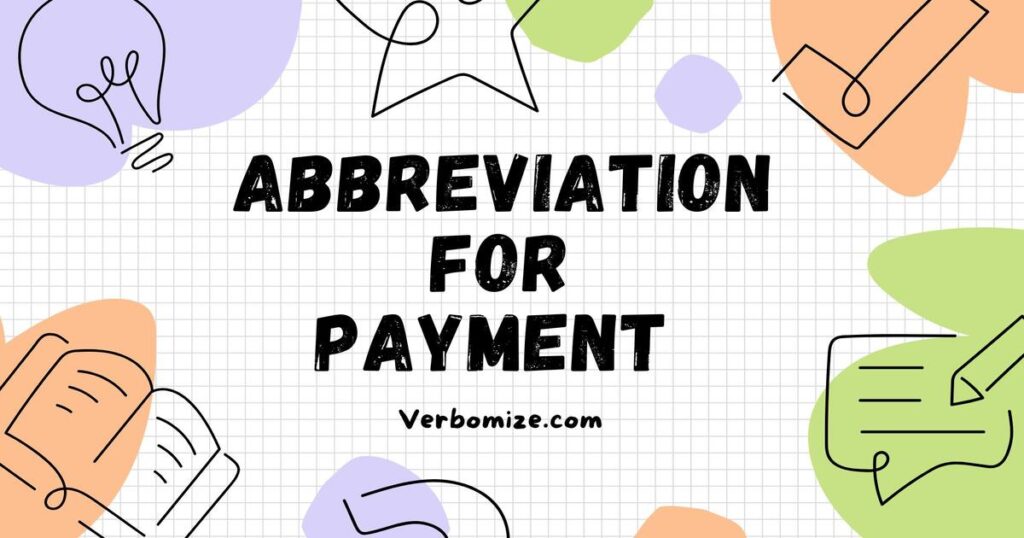Looking for the abbreviation for payment? You’ve come to the right place! In today’s fast-paced world, understanding common abbreviations can save you time and help you communicate more effectively. Payment terms are no exception, and knowing the right abbreviation can make all the difference in personal finance, business transactions, and everyday life.
In this article, we’ll dive into the most widely used abbreviations for payment and explain how they’re used in various contexts. Whether you’re managing your own finances or dealing with business transactions, this quick guide will keep you in the loop!
What is the Abbreviation for Payment?
The abbreviation PYMT stands for payment. It’s commonly used in accounting, invoices, receipts, and other financial documents to shorten the word “payment” and save time. Using abbreviations like this is a standard practice in financial and business transactions where clarity and brevity are key.
Why are abbreviations used? In fields like accounting, finance, and business, professionals handle vast amounts of data every day. By using abbreviations, they can reduce the space used in documents and streamline communication without losing meaning.
PYMT is just one example of how the payment term gets shortened. Understanding these abbreviations is essential for anyone involved in managing finances or business operations.
The Meaning Behind Abbreviations in Payment
Abbreviations for payment like “PYMT” are used to simplify the way we talk about transactions. The term “payment” refers to the transfer of money in exchange for goods or services. PYMT serves as a shorthand, making financial documents cleaner and easier to process, especially in high-volume environments such as banks or businesses.
Abbreviations are especially useful when dealing with invoices, receipts, bank statements, or even online payment systems. For example, instead of writing “payment due” or “payment received” on every document, you can simply use “PYMT.” This saves space and reduces the time spent processing documents.
Breaking Down “PYMT”: Definition, Pronunciation, and Examples
The abbreviation PYMT is simply a shortened version of the word “payment.” While “payment” is often pronounced as /PAY-mint/, PYMT is spoken exactly the same way.
Here’s an example of how PYMT might appear in a real-world context:
- Invoice: “The PYMT reference on your invoice indicates the amount you owe for this service.”
- Email: “Please ensure the PYMT is processed before the end of the month to avoid late fees.”
As seen above, PYMT is often used in invoices, receipts, and financial documentation to refer to the transfer of funds. These examples highlight how the abbreviation helps simplify the process of referring to payments in business communication.
Common Uses of the PYMT Abbreviation
In everyday business operations, PYMT is used extensively. Here are some common scenarios where you might come across the abbreviation:
- Invoices: Businesses often list “PYMT” next to the amount due to indicate a payment expectation.
- Receipts: A payment receipt may show PYMT as a record of a transaction completed.
- Accounting Statements: Financial reports or bank statements often use “PYMT” to represent incoming or outgoing funds.
- Online Payment Systems: Many digital payment systems, like PayPal or Venmo, include the abbreviation PYMT in transaction details for simplicity.
In essence, PYMT makes documents more concise, which speeds up transactions and reduces the risk of mistakes.
Other Payment Abbreviations You Should Know
Along with PYMT, there are several other abbreviations related to payments that are commonly used in business and finance:
| Abbreviation | Meaning | Common Usage |
|---|---|---|
| Pmt | Payment | Commonly used in invoices and receipts |
| AP | Accounts Payable | Refers to money a company owes to suppliers |
| AR | Accounts Receivable | Refers to money owed to a company by its customers |
| CC | Credit Card | A method of payment, usually on invoices or transactions |
| ACH | Automated Clearing House | A network for processing payments between banks |
These abbreviations are frequently used across different sectors of the finance world. They help convey complex ideas in a simple, standardized way. Understanding them helps individuals and businesses communicate efficiently.
Short Forms and Alternative Abbreviations for Payment
While PYMT is one of the most common abbreviations for payment, there are other short forms used in specific contexts. For example, some people prefer the abbreviation “Pmt” as an even shorter form of the word “payment.”
Other variations include:
- Paymnt: Another way to abbreviate “payment,” commonly used in emails or digital communications.
- P/O: Purchase Order – used to refer to a document that authorizes a payment for goods.
- Chq: Check – another term for payment via written order from a bank.
While PYMT is by far the most common abbreviation, it’s important to recognize these other forms so you can understand all financial documentation you may encounter.
What is an Acronym for Payment?
An acronym is a type of abbreviation that uses the first letter of each word in a phrase to create a shortened version. For example, the acronym AP stands for Accounts Payable. It’s different from an abbreviation because an acronym is formed by combining initial letters, while an abbreviation simply shortens a word.
Examples of Payment-Related Acronyms:
| Acronym | Full Term | Meaning |
|---|---|---|
| ACH | Automated Clearing House | A payment network for transferring funds |
| EFT | Electronic Funds Transfer | A system used to move money electronically |
| CC | Credit Card | A form of payment using a credit card |
| AP | Accounts Payable | Money owed by a business to suppliers |
These acronyms are frequently used in accounting, banking, and business to quickly refer to specific processes or systems related to payments.
Synonyms for Payment
The word payment is synonymous with several terms depending on the context. While PYMT is a standard abbreviation, understanding synonyms can enhance your financial vocabulary. Here are some commonly used synonyms for payment:
- Transaction: A broader term that refers to any exchange, including payments for goods or services.
- Remittance: Refers to a payment, often sent across distances.
- Settlement: The completion of a payment process, usually after an agreement or contract.
- Compensation: Payment made for work or services rendered.
- Fee: A charge paid for a specific service or privilege.
Each synonym can be used in different financial contexts. For instance, remittance is frequently used for international payments, while transaction covers a wide range of payment-related activities.
Antonyms for Payment
While the term “payment” refers to the act of transferring money, its antonyms focus on situations where money is not being exchanged or owed:
- Debt: Money that is owed but has not been paid yet.
- Non-payment: The failure to make a payment when due.
- Default: Failure to meet a payment obligation, often leading to legal consequences.
In understanding payment, it’s crucial to also know these antonyms, as they help highlight the opposite situations in financial dealings.
The History of Payment Abbreviations
The history of payment and its abbreviations stretches back hundreds of years. The term payment derives from the Middle English word “payment,” which is related to the Latin verb pensare (meaning “to weigh” or “to pay”). Over time, as commerce and business evolved, the need for shorthand terms like PYMT grew.
The abbreviation “PYMT” likely came into common use alongside the rise of digital payment systems and online commerce. The transition from paper-based transactions to electronic payments meant that businesses needed a quicker and more efficient way to handle vast amounts of data. Abbreviations helped streamline accounting processes, saving time and reducing the risk of errors.
When to Use “PYMT” in Communication
The abbreviation PYMT is ideal for use in formal business communications, such as:
- Invoices: To indicate the payment amount or due date.
- Receipts: To show proof of payment.
- Emails and Contracts: When discussing payment terms or confirming transactions.
However, it’s important to use abbreviations like PYMT in the right context. When communicating with customers or clients who may not be familiar with the term, consider spelling out “payment” to avoid confusion.
Real-Life Examples of “PYMT” in Action
- Example 1: “Your PYMT of $100 has been processed successfully. Thank you for your prompt payment.”
- Example 2: “Please ensure the PYMT for this invoice is completed within the next 7 days.”
- Example 3: “The PYMT reference number is required for tracking your transaction.”
These real-life examples demonstrate how PYMT can simplify communication, making it clear and efficient without sacrificing meaning.
Final Thoughts on Payment Abbreviations
Understanding the abbreviation PYMT and other payment-related terms is crucial in today’s fast-paced business and financial environment. These abbreviations allow for quick communication, clearer financial documentation, and smoother transactions. By familiarizing yourself with these terms, you can enhance your ability to navigate financial documents and engage in business operations more effectively.
Whether you’re dealing with personal finances, managing business transactions, or working in a financial setting, knowing the right abbreviation for payment will help streamline your communication and ensure accuracy in every exchange.
By exploring payment abbreviations, acronyms, synonyms, and antonyms, you can enhance your financial vocabulary and better understand the language of finance. Keep these insights in mind as you engage with financial documents, and you’ll be ahead of the curve in managing your finances and business operations.

Jone Smith is an experienced blogger and content creator behind Verbo Mize. With a passion for storytelling and insightful commentary, Jone brings a wealth of knowledge on diverse topics. His expertise in blogging, combined with a keen eye for detail, makes his work both informative and engaging, offering readers valuable perspectives on a wide range of subjects.







